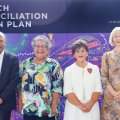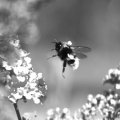Researchers from three Australian universities have devised a novel high-technology method for scientifically documenting the impact of cane toads on Northern Territory frog populations.
Scientists from the Universities of Queensland, New South Wales and Melbourne have invented and established a network of solar-powered computer systems south of the Kakadu wetlands to record frog calling activity before and after the arrival of cane toads.
The relatively cheap, high sampling remote method of monitoring fauna has attracted much scientific interest, particularly in electronics and computer journals.
It is the first known scientific experiment of its kind in the world and over the next five years is expected to yield firm scientific data on the impact of cane toads on native fauna.
An expedition in January established 10 of the recording stations set out in pairs in the 120km stretch between Roper Bar and Mataranka. The systems will be fully instrumented during the year as part of the $90,000 CSIRO-sponsored project.
Head of the University of Queensland's Zoology Department Professor Gordon Grigg, who devised the project, said cane toads were invading the Northern Territory top end from the south-east from Queensland in the past few years and had been recorded as far as Roper Bar.
'The question was to find an objective way to quantify the impact of cane toads on local fauna and we thought native frogs were a good group to study,' he said.
'As yet we have no firm scientific evidence of the effect of cane toads on fauna species, although several studies are under way.
'We thought frogs were most likely to suffer from the arrival of toads, possibly because of the direct competition between adult frogs and toads for food, and competition between tadpoles in the waterholes.
'We thought a good way might be to record the calls of the 22 frog species in the region as an indication of species diversity and density, and see how this changed over time after the arrival of cane toads. Each frog has a signature call, while the cane toad sounds like a diesel engine, so we should be able to pick up the precise moment of their arrival.
'We could hardly leave tape recorders running remotely, because there wouldn't be anyone to change the tapes, so a small team of people was recruited to work on the problem.'
Dr Andrew Taylor, of the School of Computer Science and Engineering at the University of New South Wales - an expert in machine languages - wrote a software program enabling computers to be put into the recording system to recognise each frog species separately, and also cane toad calls, logging the identification directly to memory.
The computer systems are located in hollow poles (actually six metre tall discarded light poles from the University dump) and powered by solar-recharged batteries in a system manufactured by the Zoology Department workshop.
'Calls are recorded by microphone, then fed into each computer's sound card and at the end of a season a visiting researcher with a laptop can download data,' Professor Grigg said.
Dr Hamish McCallum of the University of Queensland's Zoology Department designed the scientific methodology for the experiment, while Dr Graeme Watson, of the University of Melbourne's Zoology Department, who is an expert in frogs of the region, will help identify species.
Professor Grigg said the January Wet Season trip established the poles in reinforced concrete footings dug to the depth of a metre, with concrete made on site, and poles bolted in place. Ten people, including staff, postgraduates and volunteers worked on the arduous project in sweltering conditions over two weeks, and completed instrumentation of four poles.
He said that a major outcome would be the development of a methodology which could be used for other types of remote monitoring of biological (or other) activity.
'In many places there is concern over populations of remote species. Researchers can't be there all the time to record species, especially in hours of darkness, over six-month time frames. This system presents a simple way to provide high sampling intensity for the activity of any species which is vocal,' he said.
'The same technology also could be adapated for industrial use.
'For example, it might be possible to train a system in a jet aircraft to listen for the first sounds of trouble in an engine.
'Often a change in the sound is the first indication that something is wrong in a mechanical system.
'I suspect that all sorts of applications are possible,' Professor Grigg said.
For further information, contact Professor Grigg, telephone 07 3365 2471.



